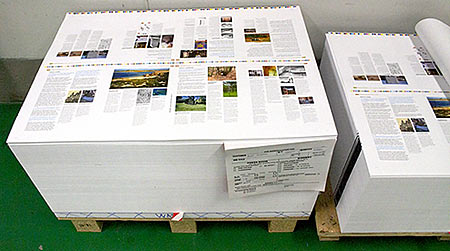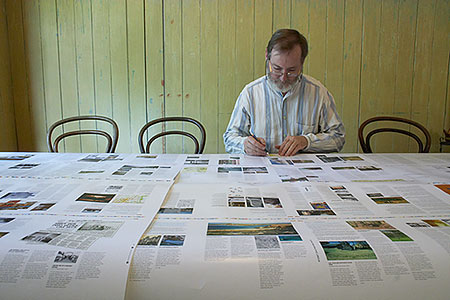Marking time in August 2004
Press check
Another milestone passed. Tonight I saw the first sheets of the book cover come off the press. I went out to the printing works and watched the press operators run a series of test sheets through the press, measure the density of the colour control patches and tune the ink flow to different parts of the plates.
The book cover includes nine photographs. Except for one digital camera file, they are all reproduced from scans that I made of prints, transparencies and negatives. I had to learn some new tricks, and I was apprehensive about the result. It was a relief to see accurate colour reproductions coming off the press, and a pleasure to sign the approved stamp on the sample sheet.


Father’s night
From Sally, an invitation:
Dear Dad
You are invited to Father’s Night
This is a night when you and I can play with the things that I love doing at preschool. We will finish with supper so could you please bring a very small plate of food to share.
From Sally

The way we do business in the military
From a mailing list message from an American soldier in Afghanistan:
Technology has changed the way we do business in the military. It does seem somewhat bizarre to have unfettered internet access in the middle of nowhere. I can sit in my tent with my ThinkPad and email, IM, and browse the internet the same as if I was sitting in my living room back in Georgia. Myself and 39 other buddies purchased a satellite system from an outfit out of India. The ISP is actually in Germany and we get just about T1 bandwidth which is split up 40 ways if everyone is on (which doesn’t occur due to different work shifts). We “beam” it out via Wi-Fi to the different tents. Even our aircraft (I’m in a CH-47 Chinook unit) are on an intranet of sorts. The system called Blue Force Tracker allows secure tracking of all the different aircraft (and ground elements) within the theater real time. We can email between aircraft and to our headquarters during flight…all with satellite technology. I’ve hardly sent a snail mail letter since I’ve been here.
Checking the proofs
At last. The book should be on the press this week.

Doh!
This morning Margie and I took a walk around Highgate Hill. Just checking on things that have changed, and things that have not, while we were away. We sadly counted the old houses being demolished in Dornoch Terrace, and glumly inspected where The Gully used to be.
But there were good things too. The City Council has been at work in the little park at the top of the hill. Paths and seats have been repaired. The gardens have been tended.
At the highest point in this park stands a concrete pedestal. There used to be a brass disk on it, engraved with pointers and text identifying the landmarks — the river, the city hall, distant mountains. Years ago the disk was carried off by vandals and, for most of the time I have lived here, the top of the pedestal has been bare.

Now at last, the pedestal has been repaired, and the disk replaced by a sundial.

It’s a cast bronze sundial of conventional design and middling quality. So far, so good.

But we have a problem. The pedestal stands inside (that is, shaded by) the beautiful little viewing pavilion. What were they thinking of?
Driving a nail
Thanks to Jeremy for pointing out the New York Times’s obituary for Henri Cartier-Bresson. It contains this quote from the photographer:
My contact sheets may be compared to the way you drive a nail in a plank. First you give several light taps to build up a rhythm and align the nail with the wood. Then, much more quickly, and with as few strokes as possible, you hit the nail forcefully on the head and drive it in.
I’m unlikely to ever see those contact sheets, so I have to rely on clues like this one from the obit:
Photographers and others who saw him work talked about his swift and nimble ability to snap a picture undetected (sometimes he even masked the shiny metal parts of his camera with black tape). They also admired his coolness under pressure. Louis Malle remembered that despite all the turmoil at the peak of the student protests in Paris, in May 1968, Cartier-Bresson took photographs at the rate of only about four per hour.
Henri Cartier-Bresson
Henri Cartier-Bresson died today. Magnum Photos, the agency he co-founded in 1947, has published a collection of photos of him.
